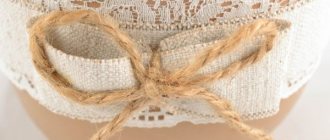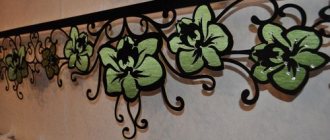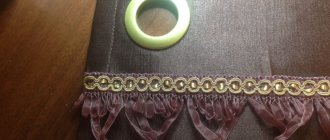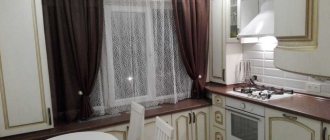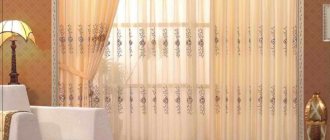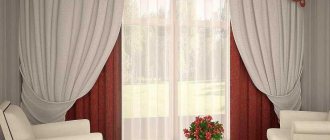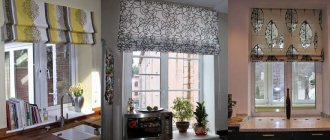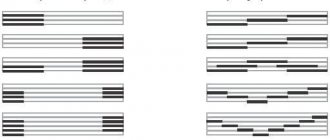Beautiful curtains for the kitchen, photo
Before settling on any specific curtain model, you need to consider the following factors:
- interior design of the kitchen so that the product successfully complements the interior.
- amount of sunlight. If the window is shaded by trees, the model is chosen in light colors, preferably tulle or organza.
- The location of the sink under the window requires short curtains.
The main thing in choosing curtains for the kitchen is convenience and practicality.
For small rooms, it is better to sew short curtains, up to the window sill or the middle of the window. This is especially true in cases where the window sill serves as a work area. It is better to opt for models adjacent to the glass: Roman, roller or blinds. Roman curtains
Curtain blinds
The classic model of two curtains on the sides and a curtain will look good on a large window. Eyelets, loops and bows are used to attach curtains.
The classic model is slightly modified for a small space, for example, one curtain is attached or two crossed panels are selected for the cornice.
The unity of colors of curtains and the decoration of chairs, tablecloths or pillows in the corner will bring originality to the interior.
A novelty is the “cafe style” style of curtains, when a crossbar for two short curtains is attached to the middle of the window, and the top of the window is decorated with a lambrequin.
Window decoration in Provence style is a combination of harmony and practicality.
An interesting idea for curtains with a slit, so that when the door to the balcony is opened, the main decor remains intact. And the cornices are placed asymmetrically to complement the interior design.
Ethnic style is based on a simple cut. It is enough to cut out rectangular panels and a simple lambrequin in the form of a rectangle to fit the window size. Seam allowances are provided on the parts.
For bay windows, an acceptable rule is: for small windows, Roman blinds are suitable; for an opening along the entire length of the wall, curtains are suitable.
Curtains in the English style will bring both aristocracy and severity to the interior. They consist of a rectangular panel in which special cords form wavy folds in several places. Such models are not sewn below the window sill.
Creating a unique decor
Curtains are one of the means of creating original and unique room decor. With the help of curtains you can visually “spread” or narrow the space, darken, or vice versa, give more light. But what you need to start from is the general idea of the interior.
Curtains are one of the means of creating original and unique room decor.
In a high-tech or loft-style kitchen, heavy velvet curtains will look ridiculous. And in a classic kitchen with an abundance of decor, minimalist roller blinds with a geometric pattern will be eye-catching.
In a high-tech or loft-style kitchen, heavy velvet curtains will look ridiculous.
- To create a country-style kitchen, use fabric of the same shade for curtains and other textiles. A drawing is required. The most popular are checks, stripes, flowers, pictures on the theme of village life (fruits, vegetables, houses, etc.).
- A minimalist kitchen is characterized by a minimum of textiles. Therefore, if curtains are used, they are in the form of roller blinds.
- For high-tech style, plain curtains in cool colors are most suitable.
- In a Provence style kitchen, the emphasis is on warm, pastel colors. Light fabrics are used, but the curtains should not be “overloaded” with patterns. Gilded ornaments are inappropriate here.
- Roman blinds will look good in a classic kitchen. In this case, the emphasis is on the drawing. Both gilding and complex ornamentation are suitable here. Jacquard curtains and tulle will also look good.
Also, when preparing for sewing, you need to evaluate the size of the window. You should not hang a voluminous structure with a lambrequin on a small and narrow window. And on a large window, short curtains cut exactly to the size of the window opening will be lost.
See alsoWhat tulle looks like in the interior, photo.
How to sew a curtain for the kitchen with a lambrequin, patterns step by step with photos
Decorating windows with lambrequins will not only decorate the kitchen, but will also hide the cornice and fixtures from prying eyes. The product can be simple, soft, hard, combined and figured. To sew a lambrequin, rectangular or shaped panels are used, and they are decorated with bows, ribbons and fringe. Satin, silk, voile, polyester, linen and even velvet are suitable for lambrequins.
To get started, you need to do the following:
- remove window dimensions;
- decide on the model;
- make a sketch;
- determine how much the lambrequin should cover the window;
- cut out the pattern;
- start sewing.
For a cornice 180 cm long you need:
- two-color veil, for example, cream and white;
- 9 eyelets;
- bias satin trim.
Progress:
- A 45x404 cm rectangle is cut out of a cream voile. The sides and bottom are trimmed with bias tape. A trapezoid with an elongated angle, measuring 202x45x100 cm, is made of white material. Three edges, except the top, are also treated with trim.
- Two pieces folded together are connected at the top. The edges are overlocked and then folded and stitched.
- The lambrequin is turned out and smoothed. On top, 1 cm away from the top edge of the panel, make marks for the eyelets. Having folded the workpiece in half, mark the central fastening, and then mark the rest at a distance of 40 cm.
- Attach the lambrequin to the cornice with ties made from tape. It is threaded through the eyelets and knitted with loops to the cornice.
Arch curtains for the kitchen, patterns step by step with photos
Arched curtains are characterized by an arched shape and hanging edges. Such models are ideal for small spaces, especially in the case of a window sill-work area. Curtains are often used for classic and rustic styles. A curtain in the form of an arch should be draped, so translucent fabrics are used for it: tulle, organza, veil. For sewing, a material with a width of at least 100 cm is suitable, but the dimensions of the window are taken into account.
The color of the arched curtain can complement the shade of kitchen textiles.
Option No. 1 Classic arch
- To cut a semicircle, divide the width of the window by three. This will be the radius.
- The material is folded in half and a semicircle is cut out according to the pattern. Its edges are covered with braid.
- The length of the curtain is measured in two ways: the window height is multiplied by 2 + 2 r or the window height + hanger + 8 cm.
- Rectangles are cut on both sides of the canvas, the base of which is equal to 1/5 of the width of the window.
- Braid or adhesive tape is sewn on top.
Option No. 2 Curtain with a patterned bottom In this option, we’ll look at how to sew an arch to preserve the bottom tulle pattern. In such cases, a semicircle is made on top.
- First, measure the dimensions of the window and make a rectangular blank, not forgetting about the seam allowance.
- Fold the material in half and cut out an arch, leaving 50-60 cm on the sides. The semicircle should be smooth.
- The sides are hemmed, and the top is folded and covered with a tightening braid.
Option No. 3 Poplin curtain In this option, a semicircle is also made on top. In order for the curtain to have flowing flounces, the fabric for the arch is taken 2 times the width of the cornice. The rectangular fabric is folded together face to face. About 20 cm are left on the sides. 1/3 of the canvas is measured straight, and then 2/3 is connected to the sides at an angle.
You can fasten the arched curtain using tape, eyelets and loops.
Kitchen curtain options
- Roman curtains
Roman blinds can be sewn from light and heavy fabric. You just need to take into account the location of the room in relation to ultraviolet radiation.
Technology for cutting Roman blinds
We will cut the material for a window opening of 140x170 cm.
- Measure the width of the window opening and add 25 cm on both sides.
- Measure the height of the window and add 12 cm to it. Based on the calculation that 2 cm will be used to fold the top seam, and 10 cm is 2 times 5 cm to fold the bottom section of the fabric.
- Double-check the window opening and decide on the number and size of folds. A complex design should appear proportional in all directions.
- Cut 2 rectangles 140x170 cm: one is a curtain, and the second is a lining material. Fold the rectangles right sides inward. Baste and stitch. Turn right side out. To get beautiful corners, they must first be trimmed by 45˚.
- Sew soft adhesive tape along the front side and turn it to the wrong side of the curtain. Sew along the bottom edge of the ribbon.
Curtain manufacturing diagram
- Mark three horizontal lines on the curtain. The distance between sections is 35 cm.
- Draw vertical lines every 28 cm. At the intersection points of the vertical and horizontal lines, sew rings for passing the cord.
- You can sew ribbons for drawstrings along horizontal lines and insert plastic or wooden slats.
- Insert a weighting agent into the hemmed bottom section. The curtain is ready!
It’s not difficult to cut Roman blinds yourself; the main thing is to take the measurements correctly and don’t forget to add seam allowances.
Curtains for the kitchen on a window with a door, options for modern curtains, patterns
Having a window with a door to the balcony in the kitchen is beneficial, but choosing a curtain for such a model is a little problematic. When choosing, you should take into account that the door will open repeatedly, and the owners will go out onto the balcony. For such windows, they try not to use bulky, heavy curtains and damaged materials. It is hardly possible to select ready-made models, because the windows in houses are non-standard. Here are three options with patterns that the housewife can sew on her own.
Roman curtain
Often, the kitchen door opens inward, so it is better to cover the multifunctional window with a Roman blind. It will fit tightly to the glass and will not interfere with walking.
Classic curtain with tieback
If desired, half of the window can be covered with a rectangular curtain reaching the floor, but it is secured at the edges with braid or chain. This model is suitable for large spaces.
Combined curtain made of tulle, which is complemented with swag.
What kind of curtains can you make with your own hands?
Curtains can enliven the kitchen interior. The choice of style is based on the size of the room. Typically, craftswomen cut the following options:
- Classic. These include drapes and curtains. Suitable only for spacious kitchens, as they have a heavy appearance. They can be long or short - depending on the features of the interior;
- Lambrequin. A very popular option because it suits many styles;
- Roman curtains. They are sewn from different types of textiles and cover only the window opening. Suitable for small kitchens, as they visually expand the space;
- French curtains. They can be combined with a lambrequin, cascade or with traditional models. They are installed on window sashes or across the entire width of the opening. More suitable for spacious kitchens in Provencal style.
Curtains for a small kitchen window, patterns, details with photos
The main requirement for curtains in a small kitchen is to visually expand the space. When choosing fabrics for small kitchens, preference is given to natural bases, because a stove is often placed next to the window. Designers choose lifting curtains: Austrian or roller blinds.
Australian curtains
Australian curtains are distinguished by their smooth fabric, with scallops formed at the bottom. Their height is adjustable. For sewing, taffeta, satin or micro-veil are used. The flounces are assembled using curtain braid and decorated with flowers and bows. For small spaces, opt for light colors.
The width of the material is determined by multiplying by two widths of the cornice. Then the canvas is divided into the number of folds required, the approximate distance between which is 30-60 cm.
Lush flounces on an arched curtain will bring coziness to a small space.
Progress:
Roll model
Roller blinds take up minimal space and do not overload the space. They are fixed with tapes and held on a rod, which serves as a weight. The curtain can be attached to the window itself or to the cornice.
Calculation of the amount of fabric
Almost anyone can sew short and simple curtains for the kitchen with their own hands. Let’s say you’ve convinced yourself that more complex products are a feasible task for you. At the same time, you even decided on a suitable model, having a photo or sketch on hand. It’s great when the chosen model is equipped with ready-made patterns, step-by-step instructions and formulas for calculations. If you have nothing but an idea, you will have to work hard.
To make kitchen curtains with your own hands, the first step is to calculate the required amount of fabric.
A number of measurements are made, including:
- window opening width;
- distance from ceiling to cornice;
- window opening height;
- distance from window sill to floor;
- dimensions of the right and left pier;
- window sill projection size;
- radiator width.
Some measurements that seem unnecessary at first glance are important precisely so that your curtains do not just obscure the window opening, but hang gracefully, freely, truly decorating not only the window, but also the wall, and with it your entire kitchen.
After measurements, we begin to calculate the amount of fabric . The length of the required cut of the fabric corresponds to the distance from the cornice to the floor or from the cornice to the window sill for shortened models with a margin of at least 10 cm for hemming at the top and 15 cm for hemming at the bottom.
The width of the fabric is calculated using the gather factor . Each model has its own coefficient. A standard curtain with a ribbon gathers with a factor of “2”, a kitchen curtain with loops – “2.5”, a light curtain with a triple gather – “3”, etc. In addition to the resulting width, add 5-10 cm per hem on both sides.
Please keep in mind that not every fabric can be used with a horizontal layout when cutting . Often, the required width has to be “drawn” based on the standard roll width. As a rule, these are 90 cm, 1 m, 1.5 m and 3 m.
Advice. In order to have as few longitudinal seams (joints) as possible, it is not necessary to strictly follow a specific assembly frequency factor. It is better to assemble the required horizontal size from several sections of suitable width.
Let's look at a clear example . To sew a shade curtain using curtain tape for a window 2.10 m wide (balcony block) with walls of 90 and 60 cm, with a height from the floor to the cornice of 2.20 m, you will need the following fabrics:
- with a canvas width of 1 m 50 cm - two cuts of 2 m 50 cm each;
- with a width of 1 m - three cuts of the same length;
- with a width of 3 m - one cut.
Before you start sewing (assembling), it is recommended to wash the fabric and carefully iron it before it dries completely. This will prevent the finished product from shrinking. Remember that two and a half meters of fabric will be shortened by 15 cm after the first wash.
It can be useful:
DIY covers for kitchen corners
Making potholders for the kitchen with your own hands
Tulle
Tulle fabrics have a mesh structure and are essentially intended for shade curtains .
They perfectly transmit light, protecting from direct sunlight, and significantly limit the view of the kitchen from the outside. Since curtain fabrics have the main curtaining effect, tulle curtains do not require multiple gatherings . It is quite acceptable to use coefficients in the range from two to zero.
When choosing tulle fabrics, pay attention to the arrangement of ornaments and patterns . If you plan to cut a fabric with a horizontal arrangement, where the width of the fabric roll will be used as the length (height) of the curtain, give preference to fabrics with a symmetrical pattern, or without it at all.
Important. For fabric with a printed or geometric pattern that is repeated along the length of the fabric (rapport), the consumption increases by the length of the repeat. For example, if the repeat size is 60 cm, fabrics are purchased 60-65 cm more than necessary. This will be needed to adjust the pattern.
Hanging tulle curtains is most often done using ready-made curtain tape . When using loops, keep in mind that the texture of the fabric does not always provide sufficient rigidity for turning the top edge. In this case, it is recommended to reinforce the seam with tape or braid.
curtain
More dense in texture and heavy curtain fabrics hold their shape well and provide a cascading visual effect. The density of the fabric is inversely proportional to the light penetrating properties. Therefore, if you do not want your kitchen to be visible to everyone in the evening, choose a thicker curtain fabric.
The curtain
excludes such types of fastenings as hinges .
The assembly frequency requires more accurate calculations using increased coefficients. Fasteners such as mortise rings require geometrically verified markings and the use of special equipment for mortising. In the case of self-made curtains, they use the services of specialized workshops for installing sewing accessories. Buy the required number of rings in advance and mark them on the fabric.
Take into account the dynamic properties of heavy, dense fabrics . The drop-down effect mentioned above appears differently depending on the direction of the cut. Even at the stage of selection in the store, the fabric is “tested” for stretching, ability to hold gathers, and folds. To do this, it is enough to unwind 1.5-2 m from the roll, lift it up vertically, then horizontally, and fold several test folds. The difference will definitely show up.
Helpful advice. It is much better if you calculate the fabric for curtains not with a measuring tape, but with a steel tape measure. It is stiffer and longer, which allows you to more accurately take all the necessary measurements and apply markings when cutting.
Short tulle curtains for the kitchen, patterns, master class with photos
Short curtains not only protect the kitchen from sunlight, but also give the housewife less trouble with maintenance. They are less fire hazardous and do not interfere with the cooking process. Similar models are needed:
- for small spaces, because a tulle curtain adds lightness and increases the volume of the kitchen.
- does not interfere with free access to the window sill, even in the closed position.
- Suitable for windows with a door to the balcony.
If we talk about short curtains, there is no consensus on what exactly the length should be: reach the middle of the window, window sill, or a short lambrequin up to 50 cm wide.
Curtain with drawstring
This model is tightened diagonally with curtain tape and assembled on one side of the window. Arched tulle curtain
Curtain with eyelets, master class with photo
The tulle curtain is attached to eyelets, creating beautiful wavy folds.
To sew it you need:
- the size of the tulle is equal to the width of the cornice multiplied by 2.5;
- finishing cuff fabric (width 25 cm);
- grommet tape;
- eyelets 8 pcs.
An approximate table of the number of hinges for a certain window width, as well as the approximate distance between the fasteners.
Detailed pattern
First, cut the tulle according to the pattern. To remove excess, just pull out the thread and cut along it. The side sections are closed. In the middle of the finishing cuff, chalk strokes are drawn along which the tape is laid. Using an ironing iron, glue it to the cuff, bend it and iron it again. In the middle, measure the seam allowance, which is also fixed with an iron. Using a machine, sew along the edges of the cuff, except for the bottom, and turn it inside out on the face. The resulting part is ironed. Tulle is placed in the cuff, sewn and ironed. From the top edge of the cuff, leaving 4 cm, mark points for eyelets. Attach the fasteners and trace their outline. Cut along the border of the eyelet, leaving 2 mm more fabric.
One part of the eyelet is placed under the bottom and snapped on top. The curtain is ready, you can attach it to the cornice.
We sew curtains with eyelets
An excellent alternative to DIY kitchen curtains with hinges would be an elegant curtain with eyelets - this is the name given to the plastic or metal edging of a hole made in the fabric. It is intended for stringing curtains onto a cornice. In a kitchen interior, this option for decorating a window opening looks very impressive.
Curtains with eyelets look impressive
The design of the eyelet curtains will be identical to the design of standard curtains. You can use any pattern you like to sew them. What complicates this model is the making of holes for eyelets and their installation. You will cope with this job with a bang if you take our practical advice into account:
- The distance between the eyelets needs to be determined in advance; this indicator will depend on the depth and relief of the folds. The most commonly used distance between holes is 18–22 cm.
Marking holes on fabric
- The size of the indentation from the top edge of the curtain to the eyelets will depend on the type of material chosen for sewing it. If the diameter of the plastic or metal eyelet rings does not exceed 4 cm, the fold size of the soft fabric should be about 6 cm.
Cutting a hole
Photos of curtains for the kitchen with your own hands on grommets can be seen on the Internet and you can bring them to life. The main thing you need to pay attention to is the correct marking for installing the grommet rings and cutting out the holes.
Curtains for the kitchen in Provence style, patterns with photos
Provence style exudes simplicity and comfort. Usually it included two rectangular panels on a drawstring with a “comb”. They are decorated with frills and picked up on the sides with ribbons and cords. Modern designs have added loops, lambrequins, bow fastenings and buttons to the rustic style. Two panels are mounted on the cornice or in the window opening.
Option No. 1 Curtain with lambrequin
The style is characterized by a texture with small bouquets of roses or lavender, which grow in the south of France.
Option No. 2 Olive ensemble
Sometimes the window opening is covered with a tulle panel and a wide lambrequin on top. The color of the material is chosen to be soft, usually olive or pastel. An example of an olive ensemble with colorful tulle.
Option No. 3 Traditional country
This model consists of traditional cafe curtains and an upper rectangular lambrequin. The shade of the curtains should match the tone of the home textiles. The pattern is given with varying degrees of completeness of the flounce.
We sew a kitchen curtain with a lambrequin
Decorating a kitchen window with translucent curtains or shortened arched curtains is common in apartments in city high-rise buildings. If you are the owner of a private house or country cottage and prefer to use hand-made style decor in your interior, then you are recommended to sew curtains for the kitchen with your own hands. Models with lambrequins will look great in any style. They look expensive, elegant and respectable. They give the decoration of a window opening a complete look.
Looking at the photo of sewing curtains for the kitchen with your own hands, you can note the following common types of decorative lambrequins:
- Single rectangular;
- Consisting of several rectangular canvases;
- Semicircular;
- Vanguard.
Curtains with a lambrequin help create an atmosphere of warmth and comfort. Soft and hard decorative options are used for sewing them. The soft lambrequin is made from the same translucent fabric, natural or semi-synthetic, as the curtain itself. To sew a solid lambrequin you need interlining fabric and adhesive tape.
Lambrequin gives the window design a complete look
Despite the apparent complexity, sewing kitchen curtains with a lambrequin is quite simple. The width of any of its models should be identical to the width of the window opening, and the height is standard - 60 cm. So:
- We take satin, mixed, cotton or synthetic ribbon to match the color of the main curtain fabric;
- We iron the canvas and cut according to a pre-selected pattern;
- We sew the edges of the future curtain from the bottom and sides;
- We fold the thickness of the cornice over the fabric from the top edge and stitch it;
- We gather the side seams onto a thread for 5 – 6 stitches;
- We hang the curtain on the cornice, tighten the satin ribbon, forming folds of the lambrequin, and tie it with a bow.
Common types of decorative lambrequins
The above master class allows you to sew stylish and elegant curtains with a lambrequin, which have an interesting design and aesthetic appearance, in a short time.
Curtains for the kitchen in a modern style, patterns with photos
Modern kitchen curtains are most often made in eco style using natural materials or in fusion style, when incompatible things are combined. Option No. 1 Italian classic The model of a simple curtain with an imperial one is successfully combined in an Italian curtain. Such models are draped with tiebacks. It can completely cover the window opening or be raised using a cord passed from the inside through a ring.
Option No. 2 Model “Blade of Grass” on rods The curtain option below is universal. It is suitable for both large and small spaces. It is easy to sew, because both parts are similar to each other, the only difference is their length. Curtains are attached directly to the window using iron rods.
The pattern is given for a window measuring 100x120 cm. The eyelets are located at a distance of 16 cm.
Option No. 3 A selection of modern curtains and tulle for the kitchen in 2018.
Design and original ideas
On the Internet you can find a lot of original ideas and finds for the design of window openings. Home craftsmen and professional designers use a variety of materials, creating real masterpieces, and sewing curtains for the kitchen with your own hands becomes a favorite hobby for many.
Creative curtains for the kitchen made from towels
Towel fabric washes very well, maintaining its original appearance for a long time. And the wide selection of colors allows you to sew a curtain from towels that will organically fit into almost any kitchen interior.
Fold the top edge of old towels so that the bottom just touches the window sill. Sew or staple the folded edges.
Sewing curtains for the kitchen from old tulle
Old tulle from the living room can get a second life as kitchen curtains or curtains. You can also combine it with new and used drapes.
You can turn tulle from a banal curtain into a stylish detail.
Sheet curtain
At first glance, bed linen has absolutely no place in the kitchen. However, as practice shows, the idea of curtaining a window with a sheet looks very original and practical.
Instead of just getting rid of your sheets, look for fun ideas for reusing them.
Knitted curtains for the kitchen - new life of an old idea
Knitted curtains do not pretend to be an opening. They have been used for quite a long time in the design of window openings and only confirm that everything new is well forgotten old. Today, this unconventional method of finishing windows is again popular and in demand.
A knitted curtain is a sign of a creative approach to the design of a room and the housewife’s ability to make beautiful things with her own hands.
French curtains for the kitchen, patterns with photos
The French model of curtains is the most pompous. It gives airiness and sophistication. Light, flowing fabrics are used for tailoring, and they are decorated with fringe, ruffles and tassels. Typically, such models are framed with double-sided curtains.
The pattern is based on vertical guides into which the tightening tape is threaded.
Option No. 2 When two shades of fabrics are combined in one model. Two sketch options for French curtains. One is decorated with flounces, the other is classic with tassels.
An example when flounces and tassels are combined on one curtain.
Styles applicable in the kitchen
In the kitchen it is difficult to imagine elaborate designs typical of the Baroque and Rococo styles. Complex draperies, composite lambrequins, multi-tiered curtains are more appropriate in large kitchens that also serve as dining rooms. In standard small-sized kitchens, curtains do not require such refinements - moreover, they will look ridiculous here.
The most suitable style of curtains for kitchens is:
- classic,
- Roman curtains,
- modern,
- country.
By the way, curtains in these styles are the easiest to sew yourself, since their patterns are quite simple, they are not difficult to find, and the sewing process is not complicated. Such curtains will look aesthetically pleasing and even impressive.
In the kitchen, light curtains are more than relevant. These curtains are also easy to sew.
Curtains with lambrequin - a fashionable and stylish solution for any kitchen
Roman blinds are a great addition to a baroque kitchen
Curtain design for a small kitchen, curtain ideas with patterns
Flowing models in light shades visually increase the space. To expand the space, use classic or asymmetrical curtains.
It is better to avoid ruffles and flounces in small-sized kitchens.
You can transform your kitchen and adjust the room if the window is placed incorrectly using asymmetrical curtains.
Roman blinds adjacent to the window are an excellent choice for Khrushchev.
Curtain elements
The type of curtains that will bring coziness to the interior of a small-sized kitchen are arched models that are loved by many. Any type and color of fabric is suitable for sewing them.
Several options for patterns of kitchen arches.
We sew simple kitchen curtains in country style
Shortened models of kitchen curtains are an excellent choice for a beginning needlewoman. They have a simple pattern and very simple sewing. In addition, they will be ideal for a small kitchen in which the window sill is part of the work surface. Cropped curtains are easy to care for. You can choose one of two types of model:
- Sliding;
- Lifting.
Short curtains are easy to care for
Sliding models fit well into a kitchen interior designed in a country style. Lifting ones correspond to classic or eco style. If your choice fell on cheerful kitchen curtains, then the best material for them would be satin, linen or cotton.
If you prefer a curtain to decorate a kitchen window, then we recommend choosing a natural translucent fabric with the addition of synthetic fibers. As for the decor, translucent curtains made in the shape of an arch or their classic versions, but gathered on the sides, about 2/3 of the length with tiebacks or curtain staples, will look very interesting in the interior of a home kitchen. For their implementation, semi-synthetic fabric that holds its shape perfectly is suitable, which can be supplemented with:
- Decorative cords;
- Drapery;
- Lace;
- Ruffles and flounces.
A fabric that holds its shape well is suitable for sewing.
One of the simple and common decors for kitchen curtains is a lambrequin. It serves as a stylish decoration and a successful addition to any model. A huge number of photos of sewing curtains for the kitchen with your own hands can be found on the Internet, along with their patterns and a list of fabrics ideal for them. You can choose the optimal option for any interior. It will be successfully complemented by the decorative design of the window opening, made by yourself.
A contrasting lambrequin serves as a stylish decoration
Curtain design for a classic kitchen, patterns with photos
For classic interiors, choose curtains made from natural materials and stick to simple models. These can be curtains with eyelets, ties, Velcro and loops. A hinged model made of lightweight materials that opens up the window sill area.
Pattern for window size 150x140 cm.
For classics, lush lambrequins are also appropriate.
A bright set of classic curtains with eyelets with a Roman model.
The cornice is attached at a height of 250 cm from the floor, the pattern size is given for a window of 115x90 cm.
Open DE JABOT or cascade
This style is simple but attractive in appearance. For symmetrical curtains, the pattern is made for only one half. The shape of the bottom and the width of the drops can be chosen as desired. With a cornice length of 1 meter, the pattern for a short curtain for the kitchen will be as follows:
- We retreat 8 cm from each edge of the cornice. The distance between the folds is calculated using the formula: (100-8*2):12=7cm.
- Mark a fold on the horizontal line with a depth of 16 cm.
- The width of the cascade is calculated using the formula: 16+77+12*16=290 cm. We leave an allowance for the hem of the bottom cut of approximately 5 cm.
Ready cascade template
Curtains for the kitchen on one side, patterns with photos
One-sided models allow the housewife to fully carry out housework, giving access to the window sill. Such models are used for windows with a door or when the frame is located in a non-standard opening.
The one-sided canvas successfully hides the flaws of the room.
Curtain with grommets, hung without a cornice.
One-sided curtain with frills, tied with a bow.
Corner curtain
A practical curtain with an angle is often used in design solutions when it is necessary to enhance the window sill.
Curtains for the kitchen, two windows, patterns with photos
Double curtains are often found in corner kitchens. They are decorated in the same style, for example a combination of tulle and classic curtains.
Pattern for a window measuring 115x90 cm, height from the cornice 250 cm.
When two windows are placed close to each other, they are designed as one whole. One of the best options for decorating double windows is roller blinds.
Airy French curtains are suitable for different types of windows.
Models for inexperienced tailors
Inexperienced needlewomen can sew various models for the kitchen with their own hands. It is enough to know how to sew a “forward needle” seam and use a sewing machine. Straight curtains for the kitchen do not require patterns; they are rectangles that you can safely sew with your own hands.
Advice! Before basting, iron the finishing allowance to the wrong side so that the fabric does not move while sewing.
Cafe curtains
Cafe style curtains can be sewn from small pieces of fabric, the length from the cornice or from the middle of the window to the window sill. Such curtains are decorated with ruffles, lace, and bows. DIY kitchen curtains made from cotton in a contrasting color with a floral pattern are beautiful and unusual.
Cafe curtains are very easy to sew and look very cozy
Curtains with ties
Rectangular curtains with ties will perfectly decorate the interior. To sew them with your own hands, you will need an amount of fabric equal to the height from the cornice to the floor (or window sill). The ties can be cut long enough to be enough to tie a knot (bow), or they can be fastened with buttons, Velcro, or snaps. Short curtains are convenient for use in the kitchen, look great, and are easy to sew. You can decorate simple curtains with ruffles, fringe, piping, contrasting fabric, as well as embroidery and appliqué.
Straight cut curtains are very easy to sew yourself
Austrian curtains
Sewing Austrian wave curtains with your own hands is possible for needlewomen of any level. First you need to calculate the amount of material, taking into account allowances for scallops. Original Austrian curtains for the kitchen, sewn by yourself, should allow light to pass through and drape perfectly.
Austrian curtains add elegance and sophistication to the kitchen interior
You can easily assemble the scallops on the curtains with your own hands and get discreet waves from the drapery. For a beautiful arrangement of scallops, as in the photo, the distance between the rows should be at least 40 cm. For beginning needlewomen, you should choose a fabric that does not fray at the edges.
If you have little experience, but want to get beautiful curtains for the kitchen with scallops without pain, then buy a special braid. It already has cords that just need to be pulled together and the folds straightened. The lower part of the curtain can be decorated with stiff textured fringe. You can sew Austrian curtains yourself to decorate a classic kitchen.
Roman models
Roman blinds are practical and convenient for the kitchen. To sew Roman blinds with your own hands, you need to take fabric equal to the perimeter of the window, take into account allowances for processing on the side of 10 cm, at the bottom 15 cm. Additionally you will need: a cord, a weighting agent, slats for hanging, Velcro for the top fastening. For the lower weighting material, it is necessary to sew a drawstring 6 cm wide; for strips, the drawstrings should be 1.5-2 cm on the wrong side of the fabric.
All that remains is to insert the strips for the folds, manually sew on the rings through which to pull the cord. In the photo you can see the details of sewing beautiful Roman blinds for the kitchen. Attach a strip with adhesive tape to the frame and hang a Roman blind. Level the tension of the cords, secure with knots in the desired position.
Advice! Simple textile curtains with large checks or large patterns should be cut in one direction to obtain a symmetrical curtain pattern.
Curtains for the kitchen from a voile, photo
Because of its delicacy and lightness, voile is often used for kitchen curtains. It transmits light well and is quite “obedient”.
The fabric does not overload the interior, but looks very elegant. A variant of two triangles that overlap each other.
The fabric for sewing must be without front and back sides.
Curtains for the kitchen made of organza, photo
Organza is a fairly popular material for sewing kitchen curtains. It varies in degree of transparency, color range, dullness and pattern. Organza is considered a capricious material, since any irregularities and flaws are visible on it.
For safety reasons, a curtain made of twisted silk fibers should not be placed near the stove.
Lightweight classic organza curtains with tiebacks.
Roller blinds can also be made from organza.
Organza curtain option with embroidery for a large window.
DIY curtains for the kitchen step by step
You can quickly make stylish Roman blinds for the kitchen yourself from old blinds. All you have to do is prepare:
- textile;
- spider web ribbon;
- special glue for fabric;
- blinds.
Blinds are selected according to the size of the window. Remove the cord that is responsible for turning the slats. But the one that lifts the mechanism is preserved.
At a distance of 25 cm, leave one strip at a time, and remove the rest by removing the lower caps with a knife.
Cut the fabric to the size of the blinds, leaving 5 cm around the perimeter for hems. The fabric is folded and ironed.
The hems are glued to the fabric with a “web”. The base is applied to the cornice and the distance of the left plates is marked on it with a pencil. The front side of the device is coated with glue, and then the fabric is pressed tightly against it. It is desirable that the material protrudes slightly beyond the top edge. The bottom bar is wrapped in fabric and fixed with glue.
The curtain is left to dry and then mounted to the frame using standard blind mounts.
Curtain open
Closed window option.
It is up to the housewife to decide which curtain option to choose for her kitchen. The main thing is to take into account all the wishes, the interior of the kitchen and the location of the window.
Sewing kitchen curtains with your own hands
Curtains are one of the brightest decorations in the kitchen. You can, of course, purchase them in a store, but it is not always possible to find among the options exactly the one that suits the owner both in price and design.
Therefore, many housewives often decide to sew curtains for the kitchen with their own hands. This decision is more than worthy of respect, but in order for the result not to disappoint, you need to prepare for the work .
First of all, you need to take measurements from the area of the room that will be occupied by the curtain. After this, you need to learn about the principles of sewing curtains with your own hands. It will also be easy to learn about this because there are various master classes in which you can learn how to sew curtains for the kitchen using a simple pattern, as well as complex products.
The choice of kitchen curtains in textile stores is quite wide. There you can find products made from organza, tulle and other materials. All these curtains are quite practical, because they do not require much attention to care.
It is enough to wash them regularly, and when they are dry, you can hang them in place without even wasting time on ironing. But still, experts recommend using natural fabrics like linen and cotton .
How to calculate the fabric size to purchase
Housewives who have plucked up the courage and are ready to start sewing curtains with their own hands, first of all, need to take the necessary measurements :
- It is necessary to determine the distance from the cornice to the bottom point where the edge of the fabric of the future product will be located.
- For curtains, you can choose a length either up to the window sill or such that they hide the radiator under the window.
- Having calculated the length of the curtain, you should add another 6 cm to the fabric for the folds at the bottom, and in addition to this 3 cm at the top. They will be needed to hem the curtain at the top. The final value will correspond to the total length of the curtain, which will help determine the consumption of material for sewing.
- After calculating the length of the cornice, you need to multiply this value by a factor of 1.5 and additionally add 4 cm, which will be needed to fold the fabric from the sides.
- After taking these fairly simple measurements, you can find out the width of the fabric for curtains with classic drapery. If you want to see a brighter drapery, then you will have to multiply the length of the cornice by 2.
Cutting fabrics for curtains for the kitchen
It is best to start sewing curtains with a simple pattern. Then you will only need one or two rectangular pieces of fabric. to moisten the material and lightly iron it before cutting This way, you can avoid shrinkage of the finished product.
In order to get an even cutting, you need, on the one hand, strictly along the edge to count the required value corresponding to the width of the future product with allowances. After this, we begin to pull one or two threads along the width of the piece of material, which will help us determine the cutting line.
It is not recommended to use sewing chalk as it can distort it. Using the same pattern, you should draw a line for the hem. After successful completion of these operations, we will have a part with perfect markings ready.


